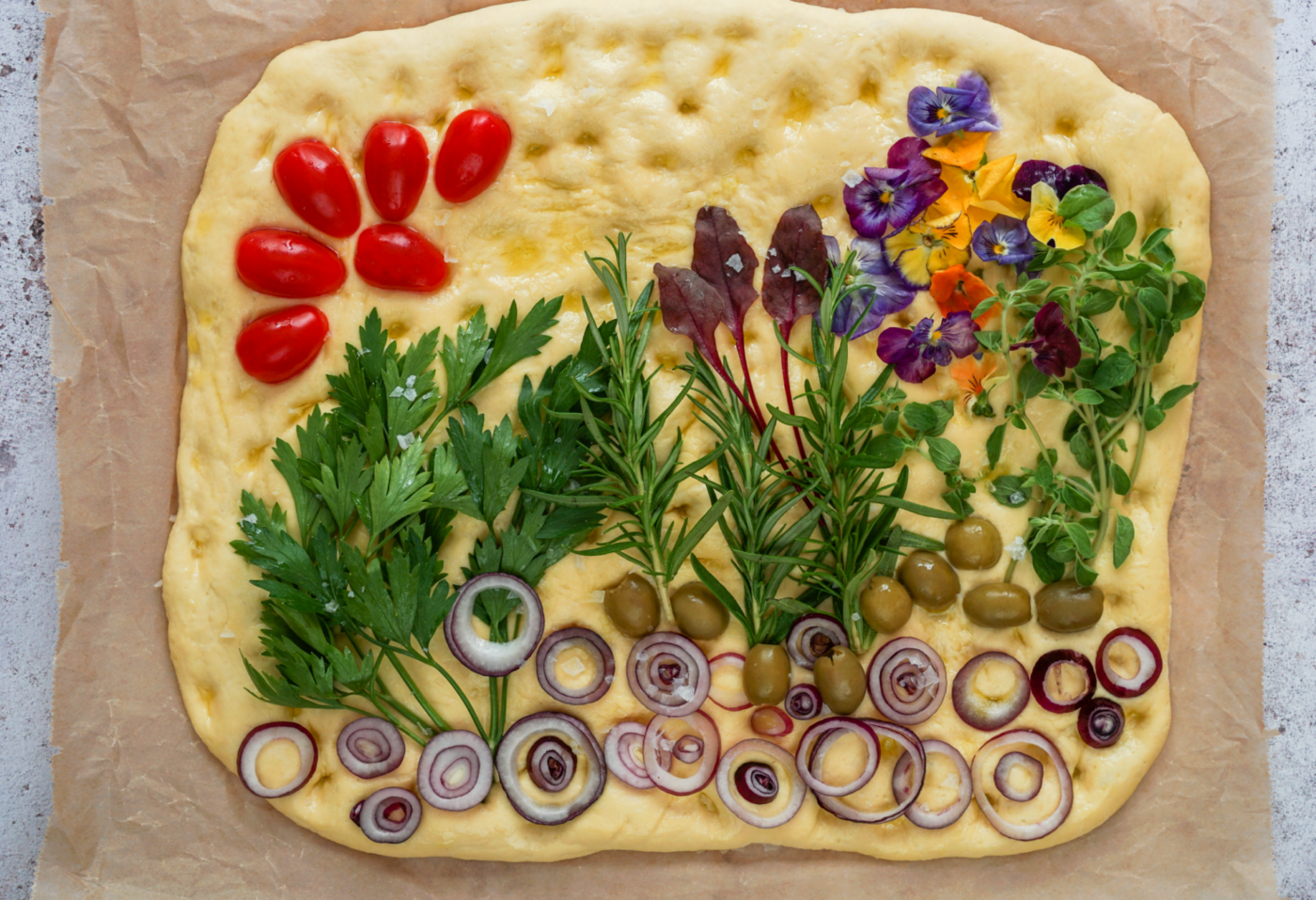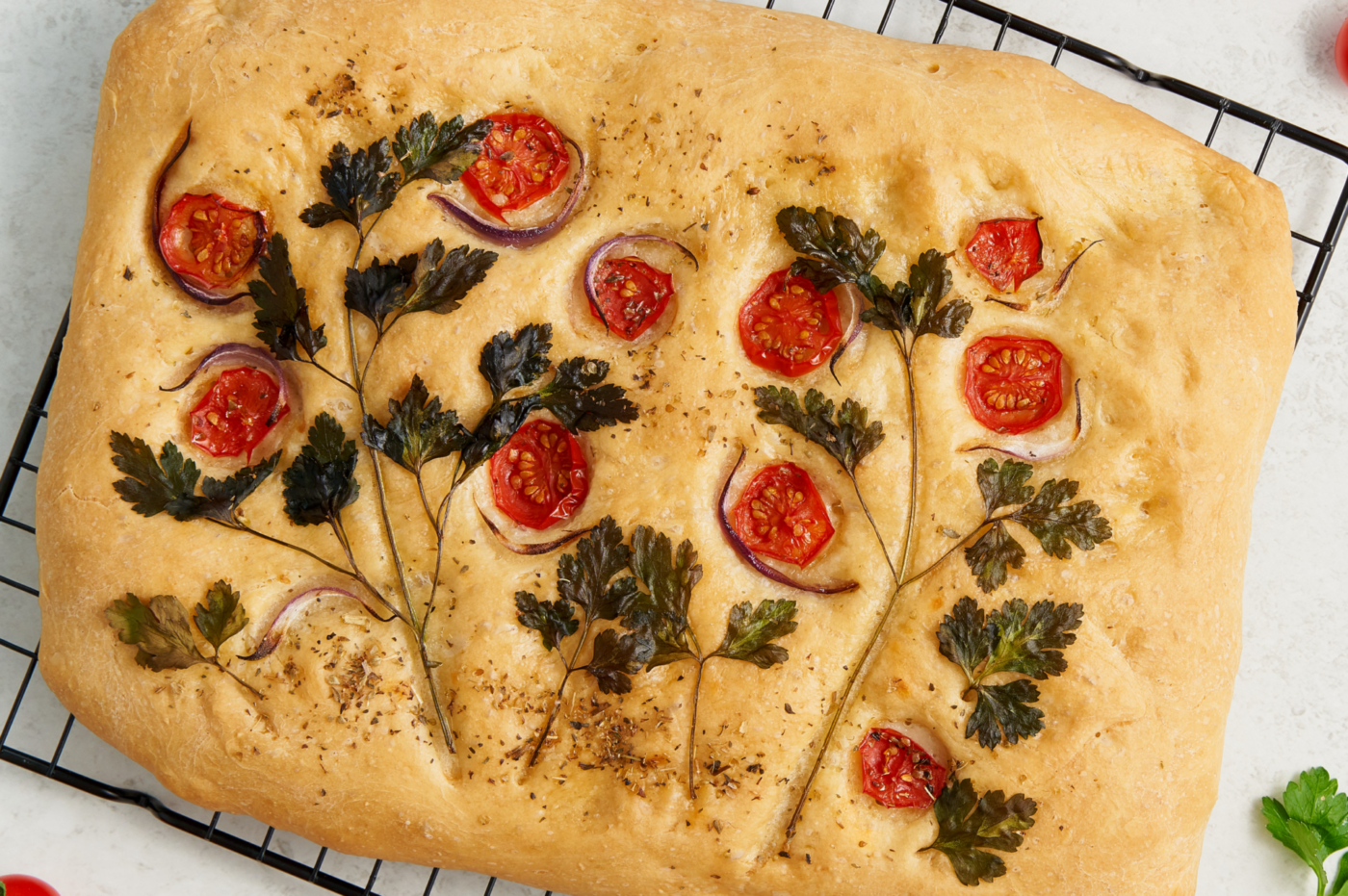Read More: History of Focaccia Bread
The Etruscan Overture: Whispers from the Hearth – The Genesis of Flatbread
Our story begins in the mists of pre-Roman Italy, within the heartland of the enigmatic Etruscan civilization. These sophisticated people, who flourished in the region encompassing modern-day Tuscany, Umbria, and Lazio from roughly the 8th to the 3rd century BC, were pioneers in various fields, including agriculture and culinary arts. Archaeological evidence, including remnants of ancient hearths and depictions in Etruscan art, suggests that they were the first to cultivate the seeds of what would eventually blossom into focaccia.
Around the 8th century BC, the Etruscans were crafting a basic yet vital form of sustenance: a flatbread they called “panis focacius.” This name, the etymological ancestor of “focaccia,” offers a crucial glimpse into its origins. “Panis” simply denoted “bread,” a universal staple, while “focacius” referred to the “focus,” the Latin term for the hearth or fireplace – the very heart of the Etruscan home. This etymology reveals that their “panis focacius” was a flatbread baked directly on the hot stones, embers, or ashes of a hearth fire. This method, born of necessity and resourcefulness, was a prevalent technique for baking bread in ancient times, before the advent of ovens as we know them.
The Etruscan “panis focacius” was likely a far cry from the airy, herb-infused focaccia that graces our tables today. It would have been a much denser, unleavened bread, crafted from simple, readily available ingredients. The type of flour used is a subject of scholarly speculation. It could have been derived from emmer, an ancient type of wheat, barley, or even ground acorns or other foraged grains, reflecting the Etruscans’ close relationship with the land. Water and perhaps a pinch of salt, if available, would have completed the rudimentary dough.
This early focaccia was primarily a source of sustenance, a staple food providing essential carbohydrates for a burgeoning civilization. The ingredients that were locally available were ground between stones and then baked on the hot embers of the cooking fire. These flatbreads may also have incorporated wild herbs or other available flavorings, reflecting the Etruscans’ deep knowledge of their environment. It laid the groundwork, the very foundation, for the future development of flatbreads in the region, a testament to the enduring power of simple, nourishing food.
Roman Refinement: Imperial Expansion and Culinary Evolution
As the Roman Republic, and subsequently the Roman Empire, expanded its dominion, it gradually absorbed the Etruscan civilization and its rich cultural heritage, including its culinary traditions. The Romans, renowned for their pragmatism, organizational prowess, and remarkable ability to adapt and synthesize the best aspects of conquered cultures, adopted the Etruscan hearth bread and embarked on a journey of culinary refinement.
Roman bakers, exposed to new ingredients and influenced by diverse culinary practices from across their expanding empire, began to experiment with the “panis focacius” recipe. They likely introduced the use of finer wheat flour, potentially durum wheat, a significant departure from the coarser grains likely employed by the Etruscans. This shift towards finer flours would have resulted in a bread with a less dense texture, a step closer to the focaccia we recognize today.
Moreover, the Romans embraced the use of olive oil, a cornerstone of their diet and a product they cultivated extensively. Olive oil, with its rich flavor and ability to create a crisp crust, would eventually become an indispensable ingredient, a defining characteristic of focaccia. The process of making the bread on hearths continued, but the use of communal ovens also began to take hold. These were often placed in public spaces, which allowed the bread-making to happen on a larger scale.
Salt became another important ingredient, not only for the flavor but also for preservation, which was important in a society that did not have refrigeration. As time went on, the Romans began to experiment with using yeast, which made the bread softer and airier.
A Mediterranean Mosaic: Focaccia’s Diaspora and the Birth of Regional Variations
The Roman Empire’s vast territorial expanse, encompassing much of the Mediterranean basin and beyond, acted as a conduit for the dissemination of its culinary traditions, including “panis focacius.” As the bread journeyed to new regions, carried by soldiers, merchants, and settlers, it underwent a fascinating process of adaptation. It assimilated local tastes, incorporated readily available ingredients, and adjusted to different baking techniques, giving rise to a vibrant mosaic of regional flatbreads.
In what is now France, “panis focacius” metamorphosed into fougasse, a distinctively shaped bread, often resembling a leaf or a ladder. This visually striking flatbread is frequently adorned with olives, herbs like rosemary and thyme, or cheese, reflecting the rich agricultural bounty of the region. In Spain, the Roman flatbread’s influence can be traced in the development of pan plano and other regional variations, each showcasing unique characteristics based on local ingredients and culinary customs. It’s even thought that focaccia is a distant relative of the Argentinian fugazza.
These regional adaptations of the original “panis focacius” are a testament to the remarkable versatility of the flatbread concept and its ability to seamlessly integrate into diverse culinary landscapes. Each variation, while retaining a familial link to its Roman ancestor, developed its own distinct personality, a reflection of the unique cultural and environmental influences of its adopted home.
The Ligurian Legacy: Genoa – The Cradle of Modern Focaccia
While focaccia was undergoing a fascinating process of diversification across the Mediterranean, the region of Liguria in northwestern Italy, particularly the bustling port city of Genoa, emerged as the true epicenter of its evolution. Here, amidst the vibrant maritime culture and the constant flow of goods and people, focaccia found its definitive form.
Focaccia alla Genovese, known locally as fügassa, evolved into a staple food for sailors, dockworkers, and the working class. Its affordability, portability, and energy-rich nature made it the perfect sustenance for those engaged in demanding physical labor. This classic Genoese focaccia is characterized by its relatively thin, crispy crust, achieved through a combination of high hydration dough and a hot baking environment.
The generous application of olive oil, both before and after baking, is another hallmark of focaccia alla Genovese. This not only imparts a rich flavor but also contributes to the bread’s characteristic crispness. The iconic dimples, created by pressing the dough with fingertips before baking, are not merely an aesthetic flourish. They serve a crucial functional purpose, preventing the formation of large, undesirable air pockets and allowing the olive oil to pool and infuse the bread with its delectable flavor.
The use of coarse sea salt, readily available in the port city of Genoa, further enhances the flavor profile and contributes to the bread’s shelf life, an important consideration in an era before refrigeration. These defining characteristics – the thin, crispy crust, the abundant olive oil, the dimples, and the sea salt – coalesced in Genoa to create a focaccia that was both delicious and practical, perfectly suited to the needs of its maritime environment.
From Medieval Monasteries to Renaissance Tables: Focaccia’s Continued Journey
Throughout the Middle Ages, focaccia maintained its status as a staple food in Liguria and other parts of Italy. It found a special place in the kitchens of monasteries, where monks, adhering to principles of self-sufficiency and simple living, often baked focaccia using readily available ingredients. The bread provided nourishment for the monastic community and was sometimes distributed to the poor and needy, further solidifying its association with sustenance and charity. These monasteries may have also been instrumental in keeping records about the bread and passing along their recipes.
The Renaissance, a period marked by a renewed interest in classical art, literature, and culture, also saw a resurgence of appreciation for traditional foods, including focaccia. Its ancient roots, tracing back to the Etruscans and Romans, likely resonated with the Renaissance spirit of rediscovering and celebrating the classical past. Focaccia continued to be a popular food among all social classes, from peasants who relied on it as a dietary staple to the nobility who enjoyed it as a flavorful accompaniment to their more elaborate meals. Its presence on tables across the social spectrum underscores its versatility and enduring appeal.
The Modern Era and Beyond: Focaccia’s Global Conquest
In more recent centuries, focaccia has transcended its origins as a humble peasant food to become a globally recognized and adored culinary icon. It has found its way into bakeries, restaurants, pizzerias, and home kitchens across the world, captivating palates with its simple yet profoundly satisfying flavors and textures.
The 20th and 21st centuries have witnessed an explosion of creativity surrounding focaccia. It has become a blank canvas for culinary experimentation, with countless variations emerging from different regions and the imaginations of individual bakers. From classic rosemary and sea salt to more elaborate toppings like sun-dried tomatoes, caramelized onions, roasted vegetables, various cheeses, and even cured meats, the possibilities for embellishing focaccia are virtually limitless.
Focaccia Today: A Culinary Chameleon
Today, focaccia stands as a testament to the enduring power of simple, well-crafted food. It remains a staple in its birthplace of Liguria, where it is enjoyed in its purest form, focaccia alla Genovese, and continues to be a source of regional pride. But it has also evolved far beyond its origins, embracing new flavors and adapting to new culinary contexts.
Focaccia can be enjoyed as a snack, an appetizer, a side dish to accompany soups or salads, or even as the foundation for a unique and flavorful pizza. Sweet versions of focaccia, topped with sugar, fruit, or even chocolate, have also gained popularity, demonstrating the bread’s remarkable versatility.
Conclusion: A Timeless Culinary Masterpiece
The history of focaccia is an epic journey, a testament to human ingenuity, cultural exchange, and the enduring appeal of simple, delicious food. From its humble beginnings as an Etruscan hearth bread to its modern-day status as a global culinary phenomenon, focaccia has demonstrated remarkable resilience, adaptability, and an uncanny ability to transcend cultural boundaries.
It is a bread that embodies the spirit of innovation, the power of tradition, and the simple joy of sharing a delicious and satisfying meal. As we savor each bite of this iconic bread, let us remember the countless hands that have shaped it over the millennia, from ancient Etruscan bakers to modern-day artisans. Let us celebrate the enduring legacy of focaccia, a true masterpiece of the culinary world, a bread whose story is far from over and whose future is as bright and flavorful as its past. It is a story baked into every dimple, every golden crust, every fragrant bite – a story that continues to unfold with each new generation of bakers and focaccia enthusiasts.


Comments